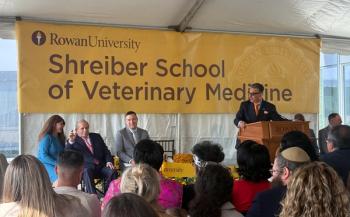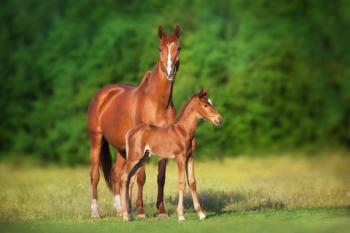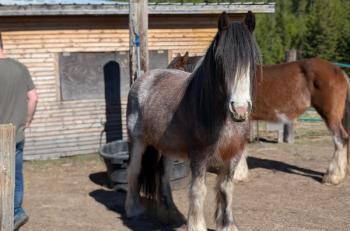
Reinforcement breeding: Ensuring mares are successfully bred
This breeding technique can help with both mare and stallion management.
For natural cover breeding programs, as is required in Thoroughbred horses, techniques can be used to help maximize pregnancy success. One such technique is reinforcement breeding.
While stallion management can be accomplished by reviewing stallion breeding records and habits, reinforcement breeding is a technique to help ensure mares are successfully bred, especially since there's variability of the natural covering habits of certain stallions.
Reinforcement breeding is allowed by the Jockey Club (Thoroughbreds), so it's permissible in the United States. The practice is not approved by certain breeding governances; thus, it's recommended to be applied only after checking on the regulations of the particular breed's governing body.
Bringing in the reinforcements: The reinforcement breeding technique involves obtaining a semen sample from the stallion after dismount from the mare and infusing that sample back into the uterus to increase the number of sperm accessing the uterus, possibly enhancing the changes of pregnancy. (Photo courtesy of Dr. Kane)
Procedure
Reinforcement breeding (sometimes called impregnation) involves obtaining a dismount sample from the stallion's penis immediately after mating and infusing that dismount sample into the uterus of the mare just mated.
"Proponents for the process claim fertility is improved, perhaps because of an increased number of sperm accessing the uterus for transport to the oviducts. Others claim the number of sperm recovered in dismount samples is too small and the quality of sperm too poor (e.g., due to cold and osmotic shock and contamination with debris) to improve fertility of most matings," says Terry Blanchard, DVM, MS, Dipl. ACT, professor in the Department of Large Animal Clinical Sciences at Texas A&M University's College of Veterinary Medicine and Biomedical Sciences.
"I think reinforcement breeding is useful in most situations, especially when stallions have large books of mares to which they're being bred, where sperm numbers placed in the uterus could be marginal," says Blanchard's colleague Dickson D. Varner, DVM, MS, Dipl. ACT, professor of theriogenology and Pin Oak Stud Chair in Stallion Reproductive Studies also at Texas A&M University.
Varner recommends maintaining the dismount semen sample at body temperature, straining it through a filter to remove extraneous debris, and then mixing the semen with a small volume of a good-quality extender. The semen is then introduced via a pipette passed through the vagina and then discharged directly into the uterine body. The semen must be grossly devoid of urine and blood.
"As the stallion comes off the mare, postbreeding, one of the stallion handlers will essentially milk the penis in a cup and collect that sample," says Pete Sheerin, DVM, Dipl. ACT, Rood & Riddle Equine Hospital, Lexington, Ky. "Some stallions are very efficient when they ejaculate, and there's no sperm from the dismount—not enough to justify using the sample."
Sometimes the remnants of the ejaculate, present in the vagina, are evacuated and reintroduced, along with additional semen, directly into the mare's uterus. "The vaginal technique depends on the stallion and mare," Sheerin says. When the stallion ejaculates, if it proceeds as it should, the stallion ejaculates directly into the uterus. "In a stallion that breeds normally and stays on the mare until he's finished ejaculating, when you insert a speculum in that mare's vagina to obtain a sample, the odds are you won't find anything."
Another stallion, however, might back off from a mare before it is finished ejaculating. Normally when a stallion ejaculates, there are five to seven jets of semen. "A horse may deposit four of them directly into the mare's uterus and, as it is coming off, leave the other three in the vagina," says Sheerin. This semen can then be reintroduced into the uterus.
Blanchard explains, "Since debris from the mating process and breeding shed floor can get into dismount samples, we believe it is wise to first filter the dismount semen sample to remove as much debris or dirt as possible, as well as to immediately mix the dismount semen sample with a suitable volume of warm extender that contains a broad-spectrum antibiotic, prior to infusion of the dismount sample into the uterus of the mare."
He notes the process might improve fertility. First, it results in an increased number of sperm placed directly into the uterus. Second, the extender could provide some protection to sperm that may improve their longevity within the uterus until they can access the oviduct where fertilization occurs. Finally, the antimicrobial present may help to control postbreeding endometritis.
Common usage for Thoroughbreds
Sheerin notes that reinforcement breeding in Kentucky is more common than it was five years ago. Part of the reason can be found in data from a study by Blanchard and colleagues that looked at reinforcement breeding, which was done while he was resident veterinarian at Hill 'n' Dale Farm, Lexington, Ky.1 That study was presented at the American Association of Equine Practitioners' (AAEP's) 2006 conference.
Records from 2005 were analyzed of mating results for 2,171 estrous cycles of 1,406 mares bred to one of 13 stallions. An attempt was made to reinforce-breed all of the mares returning for mating on second or later estrous cycles.
"Mares receiving reinforcement breeding had a greater chance of getting pregnant than mares not reinforced, which resulted in an average increase of 12 percent per cycle pregnancy rate in eight of 13 stallions in the study," says Blanchard. "The effect of reinforcement breeding was influenced by the number of sperm recovered, such that mares receiving greater than an estimated 200 million total sperm had a higher per-cycle pregnancy rate." Study results demonstrated that considerable improvement in the pregnancy rate could be achieved in some Thoroughbred stallions using the reinforcement-breeding technique.
"We did a multiple logistic regression analysis, adjusting for all the other factors that significantly affected pregnancy rate," says Blanchard. "That's important for reasons other than just looking at numbers. Using that rigorous statistical model, we found a significant increase in pregnancy rates in Thoroughbred stallions when reinforcement breeding was used. The dose affected the outcome. If we had more than an estimated 200 million total sperm that we got from drippings from the penis and put that in the mare, it was almost a 12 percent advantage; if we got less than that, it was about a 6 percent advantage.
"We've published a couple of other papers looking at factors that affect Thoroughbred stallion fertility, and we've always found an advantage for some (not all) stallions," Blanchard says.2
In a typical example, one expects good first-cycle pregnancy rates, Blanchard says. "But maybe those mares that are coming back for the second cycle need a little extra help. Perhaps the failure to get pregnant is a mare problem, or perhaps the stallion-mare interaction failed to result in a good cover. When only second-cycle pregnancy rates were evaluated (reinforcement vs. nonreinforcement breedings), reinforcement breeding improved pregnancy rates in 11 out of 13 stallions during 2005."
So, if there's some resistance to using it, Blanchard says, perhaps farm and stallion managers could see if pregnancy rates in mares that are returning for second or later cycles are improved by reinforcement breeding. "In those instances in which pretty dramatic improvement in pregnancy rates occurs, you might want to institute it as a standard practice for the rest of the season for that stallion."
In a 2010 AAEP paper, Varner and colleagues wrote that, in the five stallions examined, three had demonstrable improvements in per-cycle pregnancy rates when reinforcement breeding was used.3 "One of those stallions had a specific type of ailment—a particular type of breeding pattern—such that we thought it would help," Varner says. "The horse came off mares prematurely upon ejaculation. In the other two stallions, we didn't have anything we'd suspect would improve by using the technique. But reinforcement breeding did indeed improve those horses, even more so than the horse in which we suspected it would show an improvement."
Benefits and usefulness
Varner states that, in Blanchard's project, about 60 percent of the horses showed an improvement. "With these horses, you don't know if it will be an improvement unless you try it. Within a group of horses, you might try it where half of them get it and half of them don't, and then see what happens."
Varner notes that sometimes people won't use reinforcement breeding on the first or second cycle and then try it on the third cycle for mares that aren't getting pregnant. But, he notes, it's like comparing apples to oranges, because they're likely looking at a subfertile population of mares. To determine if the technique is beneficial, he cautions, it must be done with mares on the same cycle (i.e., used or not used for mares in cycle one, two or three). "But to compare pregnancy rate in cycle one with mares in whom it's not conducted versus cycle three in mares where it is conducted, you might see erroneous information about its usefulness," Varner says.
Sheerin concludes that reinforcement breeding helps tremendously in some horses but not in others. "In some cases they're not going to just reinforce the stallion that it helps the most, because then you're pointing the finger at him. So some farms will reinforce all the breedings, and other farms will reinforce only if the client asks for it. More clients are asking for it because of Blanchard's research."
Sheerin notes that it's fairly common to reinforce, in certain cases, all mares on a farm because the veterinarian doesn't want to raise concern about a particular stallion's reputation. "Farms that do it on a routine basis will typically do it on most, if not all, of their horses," Sheerin continues. At other farms, reinforcement breeding is done if the mare's owner or the veterinarian asks for it.
"The cases for which I recommend it depend on the mare or for a stallion that I might think has a problem," Sheerin says. "The mares I use it on are those with a cervix that doesn't relax. When a mare is in heat, her cervix is supposed to be short and wide open so the semen can go where it should. But in some maiden mares or mares that have had foaling issues and have a scarred cervix, the cervix doesn't relax like it should. Then you're concerned if the semen got into the uterus, and those are the candidate mares we would reinforce. Those mares are ones in which you would typically find semen in the vagina (as opposed to in the uterus)."
Kane is a researcher and consultant in animal nutrition. He is an author and editor on nutrition, physiology and veterinary medicine with a background in horses, pets and livestock. He is based in Seattle.
REFERENCES
1. Blanchard TL, Love CC, Thompson JA, et al. Role of reinforcement breeding in a natural service mating program, in Proceedings. 52nd Ann Mtg Am Assoc Equine Pract 2006;384-386.
2. Blanchard TL, Thompson JA, Brinsko SP, et al. Some factors associated with fertility of Thoroughbred stallions. J Equine Vet Sci 2010;30(8):407-418.
3. Varner, DD, Love CC, Blanchard TL, et al. Breeding-management strategies and semen-handling techniques for stallions—case scenarios, in Proceedings. 56th Ann Mtg Am Assoc Equine Pract 2010;215-226.
Newsletter
From exam room tips to practice management insights, get trusted veterinary news delivered straight to your inbox—subscribe to dvm360.






